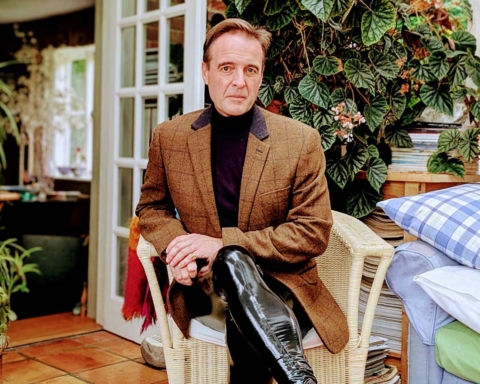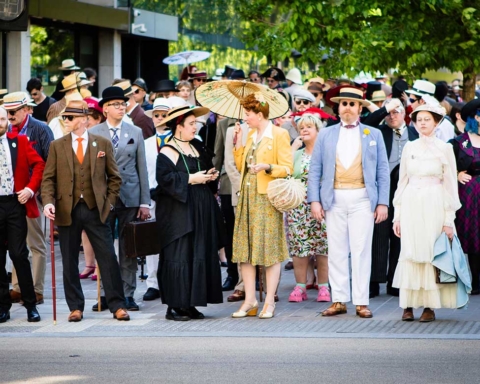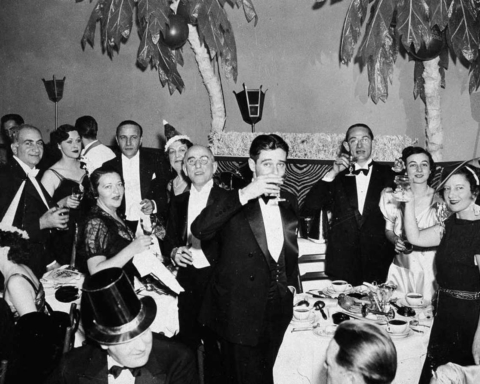The flaneurs on this year’s saunter sans purpose braved unusually clement May weather to stake their claim on the streets of London. Photos by Soulstealer Photography

The morning of Sunday 11th May 2025 was a day much like any other on Jermyn Street. A few tourists poked their heads into the windows of menswear stalwarts like Turnbull & Asser, Cheaney and New & Lingwood, probably wondering whether anyone actually dresses like that any more. They might have idly glanced at the statue of Beau Brummell, wondering who he was. Londoners went about their business, delivering important documents, attending appointments and watering the plants adorning the awnings of the shops.
Then, at midday, something shifted. The statue of Beau Brummell seemed to glimmer with a new hope, as the scent of dandyism began gradually to fill the air. Dozens and dozens of flamboyantly dressed men and women drifted along Jermyn Street from both ends, all making a beeline for the statue of their sartorial hero. The outfits these people wore ranged from 18th century popinjay to early 19th century guards officer to Edwardian cyclist to 1930s vamp to 1940s pimp; there was even a man wearing vintage Gucci from 1971, accessorised with a vintage straw boater.

Some of these gentle souls already knew each other; some were complete strangers. By 12.30 they were all friends, united for one day under the aegis of the Chap Magazine’s annual Grand Flaneur Walk. Once a year this saunter sans purpose begins by assembling every well-dressed fop, dandy, quaintrelle and boulevardier in the shadow of Beau Brummell, where they allow the many photographers to snap them in the entrance to Piccadilly Arcade. They listen to the words of Gustav Temple, who reads from one of the great flaneur texts – on this occasion it was Walter Benjamin, a 1920s German writer who devoted most of his life to writing about being a flaneur in Paris.

“The flaneur is in search of experience, not knowledge. The great reminiscences, the historical frissons – these are all so much junk to the flaneur, who is happy to leave them to the tourist. The city becomes a landscape that opens up to him and a parlour that encloses him. Just as waiting seems to be the true state of the contemplative, so doubt seems to be that of the flaneur.”

The commemorative Grand Flaneur Walk Lapel Badge, available in green or violet

And so, enlivened by this purple prose from 1929, the flaneurs embarked upon the quest they had come here for, and the business of flanning began in earnest. ‘Earnest’ might be too strong a word, for the first step taken by a flaneur is often the most cautious, especially when not a single one of them knows where they are going. This year’s Grand Flaneur Walk was so genuinely unplanned that its very organiser, Gustav Temple, immediately fell back from the herd before even getting to the end of Piccadilly Arcade. A police constable had to be consulted for intelligence on which direction a party of dapper folk had headed in.
They turned out to have turned right on Piccadilly, from whence they drifted, through swathes of confused tourists, to Picadilly Circus, where, having walked for at least seven minutes, it was agreed that a pause was required. Eros was used to pigeons flocking all over his statue and was taken aback at the quantity of peacocks that suddenly descended on him. The tourists, however, were immensely pleased, for this was what some of them had hoped Londoners actually dressed like.

The purpose of the Grand Flaneur Walk is to observe, as closely as possible, the dictum of the original flaneur, Charles Baudelaire: “The crowd is his domain, as the air is that of the bird or the sea that of the fish… for the perfect flaneur, for the passionate observer, it’s an immense pleasure to take up residence in multiplicity, in whatever is seething, moving, evanescent, and infinite: you’re not at home, but you feel at home everywhere.”
The Grand Flaneurs of 2025 took up residence in multiplicity outside the Coach and Horses, one of Soho’s most legendary hostelries, on the corner of Romilly Street and Frith Street. They had walked nearly two miles and, just like the horses and coachmen after whom the pub was named, were in urgent need of refreshment. When it was time to set off, once again the herd was separated, half of it having some second watering hole in Covent Garden in mind, others, not having heard this memo, simply wandered, hoping to find their compatriots by some miracle.

Finally, after much aimless flanning about the piazza in Covent Garden, a miracle occurred and the trailblazers were found, in a pub large enough to accommodate them all on the Aldwych, the Old Bank of England. Here the weary flaneurs and flaneuses took a well earned rest, and instead of being continually photographed by passing tourists, they photographed each other, and reflected on how singular it was to end up in a place that, only two hours ago, none of them had any idea they would be. It was universally agreed that once a year was simply not frequent enough to flan, and a Grand Flaneur Winter Walk has been scheduled for Sunday 23rd November 2025, at the same starting point as the Summer walk.







